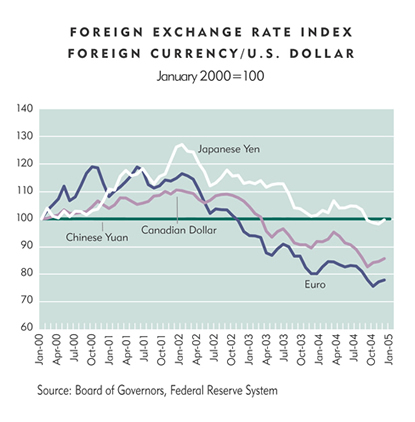Exports from district states increased 13 percent from 2003 to 2004, well above the 4.2 percent annual average growth from 1997 to 2004. Almost all manufactured exports increased from 2003 to 2004, except for a decrease of 13 percent for textile mills, which comprises the smallest share of the district's manufactured exports.
The strong gain in manufactured exports is due in large part to the weaker dollar and relatively solid economic growth abroad. The district's smaller exporting states, Montana and the Dakotas, increased at a faster rate compared with the nation and the district's larger exporting states, Minnesota and Wisconsin. In addition, after manufacturing employment decreased from 2000 to 2003, employment increased during 2004; growth in exports was likely a contributing factor.
Weak dollar, strong economies boost exports
When the value of the dollar falls relative to other currencies, foreign businesses and consumers can purchase more U.S. goods and services with the same amount of foreign currency. A weaker dollar helps U.S. manufacturers sell their products abroad. Since the first few months of 2002, the U.S. dollar has lost value relative to the euro, Japanese yen and Canadian dollar.

From the U.S. dollar's peak in 2002 relative to the euro, yen and Canadian dollar, the U.S. dollar was down 36 percent, 24 percent and 22 percent, respectively, by year-end 2004 (see chart). During 2004 the U.S. dollar decreased 8 percent, 7 percent and 4 percent, respectively. In contrast, China purchased dollars at a pace that kept the yuan trading within a band of 8.27 to 8.28 yuan to the dollar.
While on one hand a weak dollar makes exports less expensive, on the other hand, U.S. businesses and consumers pay more for imported goods and services. According to the Minneapolis Fed's survey of manufacturers, the weak dollar has contributed to higher prices for raw materials and capital goods (see related story).
Exchange rates were not the only factor to boost exports in 2004; strong demand for exports was also due to relatively solid economic growth abroad. Almost all foreign economies posted positive economic growth in 2004. Going forward, consensus forecasts among economists point toward relatively strong global growth in 2005, a good omen for this year's manufactured exports.
Exports from Montana and the Dakotas boom
Manufactured exports play a smaller role in Montana, North Dakota and South Dakota compared with other states in the nation. In 2003 these states ranked 50th, 42nd and 48th, respectively, in manufactured exports per capita.
However, from 2003 to 2004, manufactured exports from Montana, North Dakota and South Dakota increased 58 percent, 28 percent and 26 percent, respectively, pushing national rankings up a few positions in manufactured exports per capita (50th, 35th and 47th).
The strong increase in Montana was boosted by exports of chemicals, the state's largest manufactured export industry. In addition, primary metal exports more than tripled during 2004. The primary metals industry had decreased from $143 million in 1997, at the time Montana's largest export industry, to only $7 million in 2003.
In North Dakota exports to the Pacific Islands and the former Soviet republics ranked third and fourth, respectively, and both grew about 70 percent during 2004. For other district states these areas ranked relatively low. In fact, North Dakota exported more manufactured products to the former Soviet republics than Minnesota. South Dakota exports were buoyed by strong gains to the Asian NIEs (Hong Kong, Singapore, South Korea and Taiwan) and the rest of Southeast Asia.
Exports give manufacturing employment a hand
Manufacturing employment decreased for many industries in the district from 2000 to 2003. However, during the past year employment has picked up. Since manufactured exports from district states represent about 20 percent to 35 percent of gross state product attributed to the manufacturing sector, strength in export activity has likely contributed to gains in manufacturing employment.

The Bureau of Labor Statistics publishes data on several of the larger manufacturing industries in each state. Within the five district states, employment data are available for 20 industries that match the data for manufactured export industries. From 2002 to 2003 manufactured exports increased for 16 of these industries, while employment increased for only five industries (see chart). However, from 2003 to 2004, 19 of the industries posted gains in manufactured exports, while 11 industries increased employment.
Reports abound on U.S. and district jobs and manufacturing operations moving to other countries where labor costs are lower. However, other countries also provide markets for U.S. and district manufactured products. While it's difficult to identify which U.S. and district manufacturing jobs are created due to increased exports, aggregate statistics of export and job growth point toward a positive impact.
Export data were compiled by Sasha Lugovskyy, Federal Reserve Bank Intern
Ninth District Manufactured Exports
Minnesota |
Montana |
North Dakota |
South Dakota |
Wisconsin





